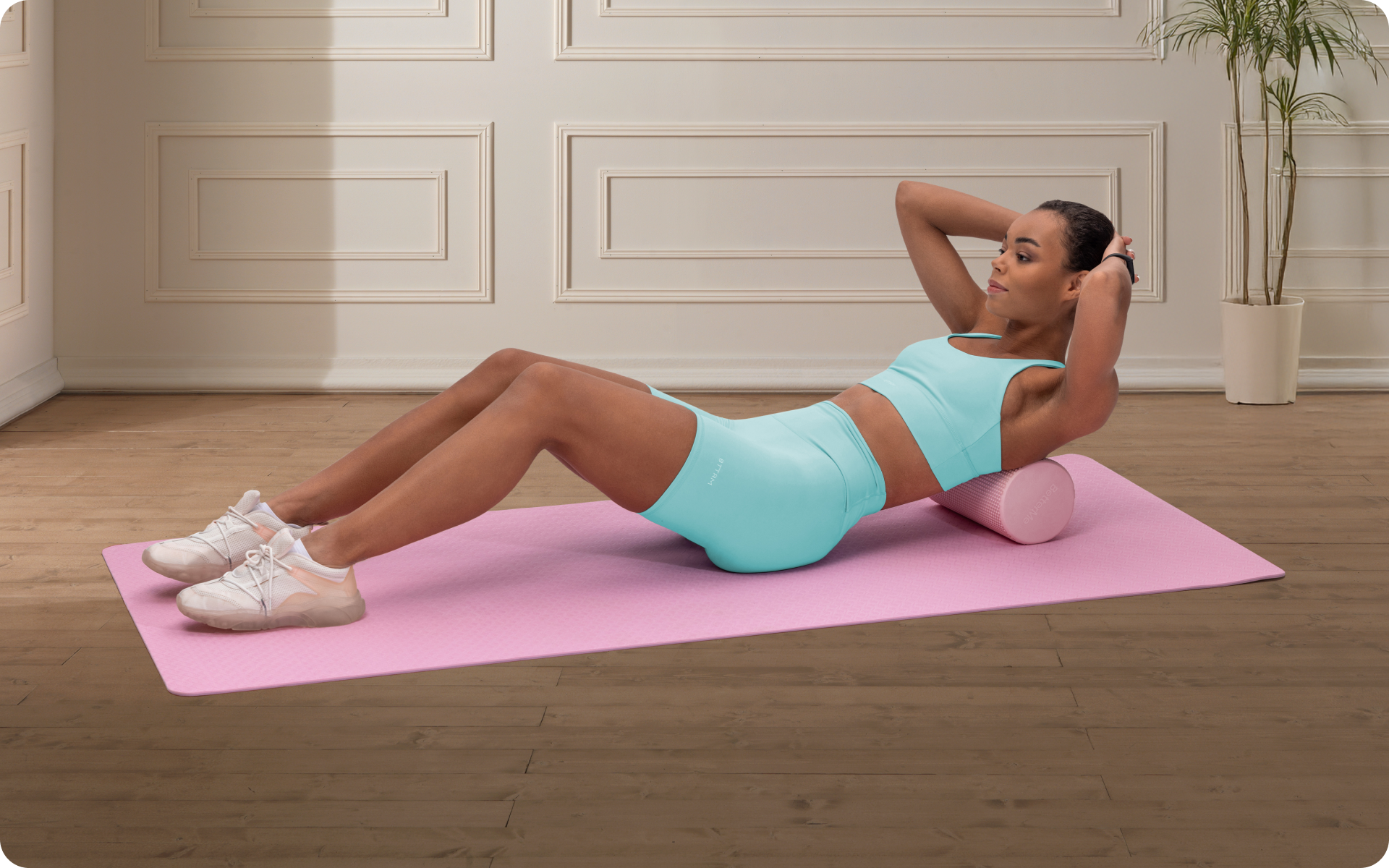When it comes to building strong, defined abs, it often starts with time. How long should your ab workout last? 10 minutes? 20? Longer? Oddly enough, the duration of your workout may not be the most important factor at all. There are many things you need to consider when questioning how to train including your goal and fitness level.
This doesn’t mean workout length is irrelevant, but the picture is more complex than just watching the clock.
Here’s what you need to know to design an ab workout that fits your goals and time limit.
Does Workout Length Affect Ab Development?
When it comes to ab development, it’s easy to assume that longer workouts lead to better results. After all, more time exercising should mean more progress, right? Not exactly.
Workout length by itself isn’t the key driver of muscle growth, including in your abdominal muscles. Instead, the focus should be on total training volume.
What Is Training Volume?
Training volume refers to the total amount of work you perform during an exercise session. It’s usually calculated as the number of sets multiplied by reps and often includes resistance or weight (1).
For example;
- 3 Sets X 15 Reps = 45 Reps (Volume)
This metric is important because it directly impacts a process called muscle hypertrophy (muscle growth) (2). The key is to create consistent, adequate stimuli, which training volume does far more effectively than simply extending the length of your workout.
The Limitations of Workout Length
Measuring progress by time alone isn’t very reliable. Two people could spend the same amount of time exercising their abs, but the one who focuses on training volume will likely see better results. Here’s why.
If you spend 30 minutes doing a high number of low-effort ab exercises, you may not reach the level of challenge your muscles need to grow.
Meanwhile, someone who spends just 10 minutes performing focused, properly executed exercises with enough intensity will stimulate their abs more effectively.
It’s quality over quantity. The length of your workout may reflect how long you’ve stayed active, but it doesn’t guarantee that your muscles were challenged enough to grow. This is particularly true for smaller muscle groups like the abs, which recover quickly and require a well-structured approach to training volume. Our previous post goes into great detail about how often should i workout abs.
Evidence Supporting Volume Over Duration
Research consistently points to the importance of training volume for muscle development. A 2019 review in the journal Medicine & Science in Sports & Exercise analyzed the relationship between weekly training volume and muscle growth. It found that more when it was managed well, greater volume led to greater hypertrophy across muscle groups (3).
While the studies didn’t isolate abdominal muscles, the principle applies universally. Your abs are muscles, just like your biceps or quads. They respond to systematic overload, not just to how many minutes you log on a clock.
Read more: Does Calisthenics Make Females’ Shoulders Bigger?
Should Ab Workouts Be Shorter than Other Muscle Groups?
Ab workouts tend to be shorter than those for larger muscle groups. This isn’t because they’re less important but because of how abdominal muscles are designed and how they respond to training.
Your abs are made up of smaller muscles such as the rectus abdominis, obliques, and transverse abdominis. These muscles have a high proportion of slow-twitch fibers (4). Slow-twitch fibers are built for endurance and can recover quickly after exercise (5). This means abs don’t require long, intense sessions to be effectively trained.
Larger muscle groups, such as your chest or legs, contain more fast-twitch fibers. These fibers are built for power but fatigue faster and need more recovery time (5). A longer workout is typically needed to challenge them sufficiently.
The abs are also engaged during many exercises that are not core-specific. Movements such as squats or deadlifts require high levels of core stabilization, providing direct stimulation. As a result, a focused 10-15 minute ab workout can easily be enough to build strength and endurance when paired with total-body training.
The BetterMe: Health Coaching app will provide you with a host of fat-frying fitness routines that’ll scare the extra pounds away and turn your body into a masterpiece! Get your life moving in the right direction with BetterMe!
What’s the Minimum Time Needed for Ab Results?
On average, visible changes in muscle tone typically take 6-12 weeks with consistent effort. However, this timeline is highly variable.
Someone with a leaner starting point and structured training routine might notice results within a month. Others may take several months, particularly if they’re starting with higher body fat or inconsistent habits.
Factors That Influence Ab Results
- Body Fat Percentage
For your abs to be visible, your body fat percentage needs to be low enough to reveal them. Even the strongest abs will remain hidden if they’re covered by a layer of fat.
- For men, this often means reaching around 10-14% body fatFor women, it’s typically closer to 16–23% body fat (6).
The speed at which you can reduce body fat depends on your overall calorie balance, physical activity, and metabolism.
- Training Consistency
As with any other muscle group, consistent training is key. This doesn’t mean doing hours of ab exercises every day. A well-designed program that incorporates 2-3 targeted ab sessions per week, combined with full-body workouts, can yield results over time.
Remember, your abs are engaged in many compound lifts and daily activities, so consistency matters more than sheer workout length.
- Diet and Nutrition
Diet plays a significant role in achieving visible abs. You need to maintain a caloric deficit (burning more calories than you consume) to shed fat while providing your body with the nutrients it needs for muscle repair and energy (7). Protein intake, in particular, is essential for muscle growth and recovery (8).
- Genetics
Genetics influence both the structure of your abdominal muscles and how quickly you can see results. Some people may naturally store less fat around their midsection, while others may have a harder time revealing their abs, even with low body fat. These genetic factors dictate how soon you’ll notice changes (9).
- Starting Point
Your current fitness level and body composition also matter. Someone who is starting at a higher body fat percentage will likely take longer to see their abs compared to someone who’s already lean. Similarly, if you’ve been training for a while and have built up core strength, results may appear faster once fat is reduced.
How Long Should an Ab Workout Be for Beginners?
For beginners, ab workouts should typically last between 10 and 30 minutes. This is usually enough time to work the muscles effectively without overloading or risking improper form. Beginners are still developing the strength, endurance, and coordination that are needed to handle longer, more intense sessions.
Beginners should prioritize mastering proper technique of exercises that target the abssuch as; p
- Plankse
- Dead bugs, or m
Modified crunches The aim isn’t to cram as many exercises as possible into the session but to focus on quality and control. By using the right form and achieving a full range of motion, even basic exercises can yield noticeable benefits. To learn more about the best ab workouts for women, check out our in-depth article on the topic.
Is There a Maximum Time Limit for Ab Training?
There’s no hard maximum time limit for ab training, but spending more than 30 minutes solely on abs is rarely necessary. The abdominal muscles recover quickly and respond better to focused, high-quality work than to prolonged sessions.
Overtraining the abs can lead to diminishing returns. Prolonged sessions may cause fatigue, which can reduce the quality of your movements. This decreases the effectiveness of the workout and can also increase the risk of straining supporting muscles such as the lower back (10).
In addition, as the core stabilizes the body during many exercises, it’s indirectly worked during compound movements such as squats, pull-ups, and push-ups. Overemphasizing ab isolation exercises could leave you fatigued for other important parts of your training.
Anywhere from 10 to 30 minutes of dedicated ab work is enough for most people. Beyond this, it’s more productive to focus on other muscles or movements that engage the core indirectly, such as deadlifts or farmer’s carries.
Can a 10-Minute Ab Workout Be Effective?
Yes, a 10-minute ab workout can be highly effective if it’s well-planned and executed with proper intensity and form.
The abdominal muscles are smaller and recover quickly, which makes them suited for brief but focused workouts. If the exercises challenge the muscles sufficiently, 10 minutes is plenty to stimulate growth and strength. High-effort moves such as planks, reverse crunches, and mountain climbers create sufficient tension within a short timeframe.
It’s also worth noting that a 10-minute dedicated ab session doesn’t work in isolation. Compound exercises in your regular routine contribute significant core stimulation (11). By combining these efforts, a short, targeted ab workout becomes even more impactful. Our previous post goes into great detail about the apron belly workout.
How to Structure a 10-Minute Ab Workout
A well-structured 10-minute ab workout can deliver impressive results when it’s designed with purpose. The key is to target all parts of the core while incorporating proper form and intensity. Here’s how to build an efficient session step by step:
1. Warm-Up (1-2 Minutes)
Start with a brief warm-up to activate your core and increase blood flow. This helps prepare your muscles for the workout and reduces the risk of injury (12). Examples of effective warm-up moves include:
- Cat-Cow Stretch – Alternate between arching and rounding your back to engage the core and warm up the spine.
- Pelvic Tilts – Lie on your back with your knees bent and gently tilt your pelvis to engage the lower abs.
- Standing Trunk Rotations – Gently twist your torso from side to side to loosen up the obliques.
Reasons why BetterMe is a safe bet: a wide range of calorie-blasting workouts, finger-licking recipes, 24/7 support, challenges that’ll keep you on your best game, and that just scratches the surface! Start using our app and watch the magic happen.
2. Main Workout (6-8 Minutes)
The main portion of your workout should focus on a mix of exercises that target different core muscles:
- Rectus Abdominis (Front of Your Abs)
- Crunches (30 seconds): Focus on slow, controlled movements to fully engage the upper abs.
- Reverse Crunches (30 seconds): Lift your hips off the ground to target the lower abs.
- Obliques (Sides of Your Waist)
- Bicycle Crunches (30 seconds): Bring opposite elbow to knee in a controlled motion for side engagement.
- Side Plank (Right) (30 seconds): Hold your body straight while supporting yourself on your forearm and the side of your foot.
- Side Plank (Left) (30 seconds).
- Transverse Abdominis (Deep Core)
- Plank With Shoulder Taps (30 seconds): Keep your hips stable while alternating taps to your shoulders without rotating your torso.
- Dead Bug (30 seconds): Lie on your back and extend one arm and the opposite leg while keeping your core engaged.
Repeat the circuit as necessary, depending on your pace, to fill the remaining time. Keep transitions quick but maintain proper form.
3. Cool-Down (1 Minute)
End with light stretches to help your core recover and release tension (12). Include:
- Child’s Pose – Sit back on your heels and stretch your arms forward for a gentle lower back stretch.
- Seated Spinal Twist – Gently twist your torso to each side to decompress your obliques and mid-back.
Tips for Success
- Focus on form over speed. Sloppy movements reduce effectiveness and increase injury risk.
- Use controlled, deliberate motions to engage the core fully.
- Gradually add resistance or intensity as you grow stronger. Small weights or resistance bands can increase difficulty without extending your workout duration.
Read more: Calisthenics Vs Weights: Which Physique Is More Appealing?
Should Ab Workouts Get Longer Over Time?
Extending the duration of ab workouts isn’t the most effective way to make progress. Abdominal muscles are uniquely designed with a higher proportion of slow-twitch fibers, which are built for endurance and recover quickly. As a result, they don’t need prolonged training sessions to be effectively stimulated.
Longer workouts can lead to diminishing returns. Over time, fatigue sets in, which affects form and reduces the quality of your movements. This decreases results and increases the risk of injury, particularly to supporting areas such as your lower back.
Instead of focusing on time, there are other ways to make your ab training more effective:
- Increase Resistance
Add weight or resistance to your ab exercises. For example, hold a weight plate during sit-ups or use a resistance band for reverse crunches. This increases the load on your muscles without extending your session. - Boost Intensity
Focus on reducing rest periods between exercises or performing more repetitions in the same amount of time. This increases muscular endurance and challenges your core further. - Enhance Exercise Complexity
Replace basic movements with more advanced ones. For example, progress from a standard plank to a plank with arm or leg lifts. These variations target stabilizing muscles and demand greater core control. - Improve Execution
Slowing down movements can dramatically increase time under tension. This enhances muscle activation and creates a more challenging session without adding extra exercises.
Yes, you can overtrain your abs with long workouts. Prolonged sessions can lead to fatigue, which affects your form and increases the risk of injury, particularly to the lower back. The abs recover quickly and respond better to shorter, focused sessions. Overtraining reduces effectiveness and can hinder recovery and progress (10). Five minutes may be better than nothing, but it’s not enough to effectively train your abs, particularly if building strength, endurance, or visibility is your goal. For balanced and effective core development, commit at least 10-15 minutes per session, ensuring you use proper form and focus on muscle engagement. You can perform 20-minute ab sessions 2-3 times per week. This frequency allows for adequate recovery while delivering consistent training stimulus. Combine these sessions with full-body workouts that also engage your core for balanced development. Short ab workouts can be better as they focus on intensity and quality, avoiding the fatigue that often comes with longer sessions. As the abs are smaller muscles with a high recovery rate, brief, efficient training stimulates them effectively without unnecessary strain. Quality always outweighs quantity when it comes to core training.Frequently Asked Questions
Can you overtrain your abs with long workouts?
Is 5 minutes enough for abs?
How often should you do 20-minute ab sessions?
Why can short ab workouts be better?
The Bottom Line
If you’re aiming to develop stronger, more defined abs, stop worrying about squeezing in lengthy workouts. Focus instead on the quality of your sessions. Plan exercises that target your abs directly, use proper form, and ensure sufficient training volume. Whether your workout is 10, 20, or 30 minutes long, what truly matters is the work you put in over that time.
DISCLAIMER:
This article is intended for general informational purposes only and does not serve to address individual circumstances. It is not a substitute for professional advice or help and should not be relied on for making any kind of decision-making. Any action taken as a direct or indirect result of the information in this article is entirely at your own risk and is your sole responsibility.
BetterMe, its content staff, and its medical advisors accept no responsibility for inaccuracies, errors, misstatements, inconsistencies, or omissions and specifically disclaim any liability, loss or risk, personal, professional or otherwise, which may be incurred as a consequence, directly or indirectly, of the use and/or application of any content.
You should always seek the advice of your physician or other qualified health provider with any questions you may have regarding a medical condition or your specific situation. Never disregard professional medical advice or delay seeking it because of BetterMe content. If you suspect or think you may have a medical emergency, call your doctor.
SOURCES:
- No Time to Lift? Designing Time-Efficient Training Programs for Strength and Hypertrophy: A Narrative Review (2021, link.springer.com)
- The Mechanisms of Muscle Hypertrophy and Their Application to Resistance Training (2010, journals.lww.com)
- Resistance Training Volume Enhances Muscle Hypertrophy but Not Strength in Trained Men (2019, journals.lww.com)
- Active behavior of abdominal wall muscles: Experimental results and numerical model formulation (2016, sciencedirect.com)
- Muscle Fiber Type Transitions with Exercise Training: Shifting Perspectives (2021, ncbi.nlm.nih.gov)
- Normal ranges of body weight and body fat (n.d., us.humankinetics)
- Optimal Diet Strategies for Weight Loss and Weight Loss Maintenance (2020, ncbi.nlm.nih.gov)
- International Society of Sports Nutrition Position Stand: protein and exercise (2017, biomedcentral.com)
- The genetics of fat distribution (2014, link.springer.com)
- Overtraining Syndrome as a Complex Systems Phenomenon (2022, frontiersin.org)
- Compound Exercises (n.d., physiopedia.com)
- Warm Up, Cool Down (2024, heart.org)











